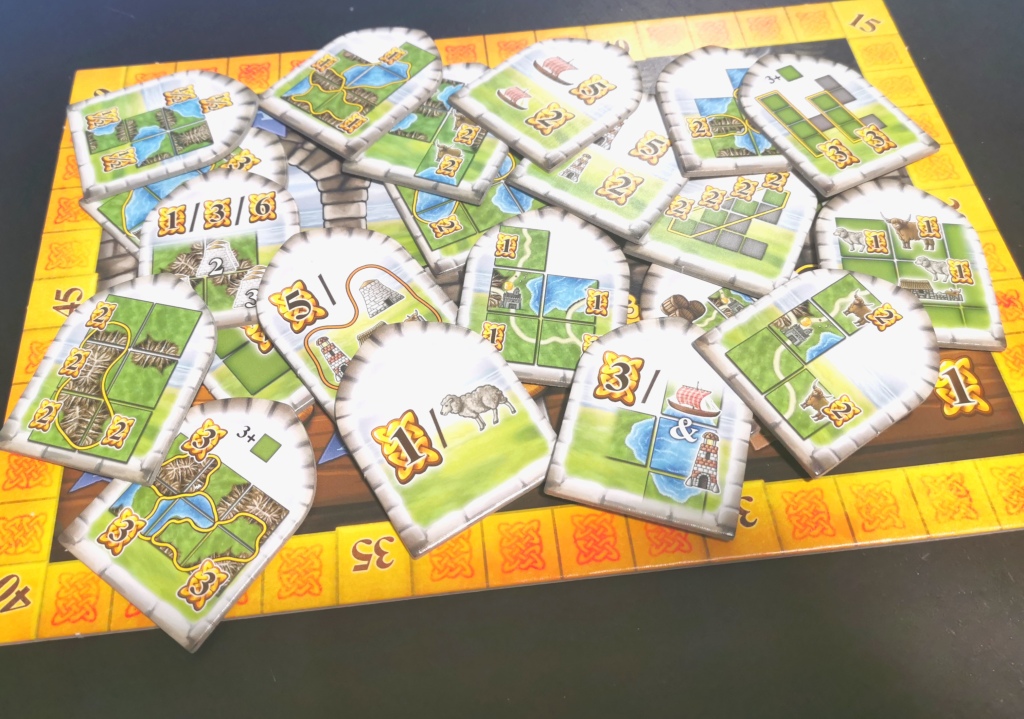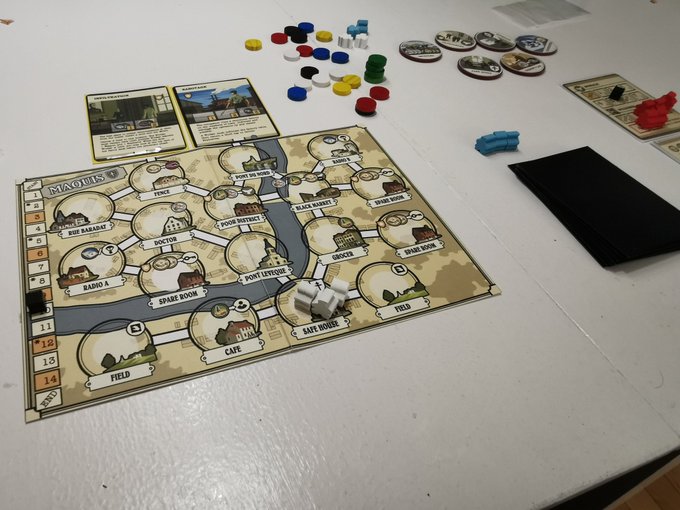In the last two entries, I’ve talked about variable setups, both what made the concept attractive, and what made that variety meaningful. Today, I’ll dig into a few games which, to me, have rocked the variable setups, and what we can learn from them to apply to our own designs. I’ve also been careful to choose 3 games which feature different types of variety, to present, well, varied variety. I’ve also stayed away from asymmetry, which I think I’ll cover in another post: these are already long enough as is.
Isle of Skye’s goals
I love Isle of Skye’s economy, but today we talk about its variable setup. Every game of Isle of Skye you select 4 scoring objectives, out of a pool of 16: even if we ignore differences in their order, that is over 1800 different possibilities. But how many of those actually feel different?

I think that there is very little overlap in those goals. For example, let’s look at the 4 tiles related to “completed areas”:
– The first gives you 1 point for every area you complete. Just complete stuff, as soon as you can!
– The second gives you 3 points for every completed area that goes on at least 3 tiles. Sure, it’s still pushing you to complete them, but it’s making you wait a bit.
– The third gives you 2 points for each Mountain completed area: you’re not trying to close off everything, you’re only paying attention to Mountains.
– The fourth gives you 2 points for each tile in your largest completed Water area, which pushes you to grow a water area as much as you can, and trying to complete it before the end of the game.
Are these all similar? Yeah, to a certain extent. But could you play a game with all four of those? Hell yes! Sure, they’re all related to the same game element, but they still push you towards different things, even if they overlap. Compare this to the ever-present “score +2 vp for each card with icon X”: they push you towards certain strategies (if that icon is actually meaningful), but they don’t lead to different games. The push-your-luck aspect of that fourth scoring tile, seeing how much you can grow it before you complete it, that is unique to this tile. If it’s not in the game, you don’t experience it.
Imagine if Isle of Skye’s scoring tiles where all what the Scroll tiles currently are: “1 point per Sheep, 1 point per Farm”. How boring would that be? Would it matter which tile comes up? No it wouldn’t: the differences between those elements are defined by the scoring tiles. In a game where neither Cattle nor Forts are featured on a scoring tile, they are actually identical: they are not to be considered unless a Scroll tile comes up, and that Scroll tile has the same odds of coming out for both, and they’d be worth the same thing. It’s Schrodinger’s Scoring Tile.
Oh yes, quantum science reference! I is smart!
So what can we learn from Isle of Skye: variable scoring conditions can be used to define the differences between elements, if they aren’t inherently different.
Ethnos’ Factions
There are 5 core rules of Ethnos:
– On your turn, you draw or play;
– Max 10 cards in hand;
– When you play a stack, they should all be of the same color or of the same faction;
– When you play a stack, discard the rest of your hand
– Playing a stack allows you to place a strength token on the region of the card on top, and trigger its ability.
Now, what those abilities are is where the game gets fun. The game comes with 12 factions, each with their own abilities, and each game features 6. The interaction between them is minimal, so Trolls in a setup with Giants feel pretty similar than in a game with Orcs.
/pic3304125.png)
So how different are they? The game has 3 elements you interact with: points, the majorities, and cards. Some factions are firmly in one: Minotaurs, Trolls and Wingfolk are solely related to gaining those majorities, Dwarves, Orcs, and Giants are solely points, Wizards and Elves are solely cards. Some have impacts on two fronts: Centaurs and Merfolk help you both in placing strength and gaining points both (although, again, they do so differently); Halflings and Skeletons are helping you in one category, but hurting you in the other. And of course, within each of those broad categories, they all work in slightly different ways: on the majority-centric trio, Minotaurs make placing Strength tokens easier, Wingfolk allow you to place those tokens anywhere, and Trolls serve as the tie-breaker; for the point-scorers, Dwarves just make your stack worth more, Orcs are a set-collection aspect, and the Giants are another majority/race aspect.
But the coolest thing to me about the variety in Ethnos is that I can cater the experience we’ll have to the group. If I’m playing with my family, I can take the simplest ones, which don’t use those weirder mechanisms. If I’m playing with a full table of 6, I try to make sure there are at least 3 point scorers, to compensate for the tougher competition on the majorities. Also, when I shuffle the randomizers and reveal 6, I can ask everyone if they’re okay with it: I personally don’t like the Minotaurs, so unless someone argues for them, I’ll take them out. If someone has a special request, I’ll put them in. Variable setup allows the design to go wider and cater to more people, because everyone can decide to ignore certain parts of the game without losing out.
Maquis’ Missions
With the whole Covid situation, I’ve finally PnP’d a copy of Maquis (which is awesome and free on PnPArcade!) and played it multiple times, and I’m hooked. It’s what inspired me to write about variable setups, because of how well it’s done it.
Many games have scenarios or opponents or maps, which go from completely changing the game to barely changing anything. My favorite game, Arkham Horror the Card Game, has some scenarios that I actively disliked, and others that I would play multiple times in a row. They vary so much. On the other hand, if somebody plays Power Grid on the North America map and doesn’t like it, I doubt they’d fall in love with the German one.

It’s a mechanic that’s old as time, but Maquis does it… perfectly. Every game uses 2 of 14 missions, which, in the end, are just pick-up-and-deliver recipes, just like in many other games. Aside from the resources they cost though, they have very important impacts on the game:
– Destroy the Train has to be completed between the 6th and 9th turns;
– Infiltration will require you to leave the first worker you send there until you send the second one;
– Assassination requires you to eliminate Militia, instead of delivering resources;
– Bomb for the Officer blocks two action spaces until you complete it;
– Take out the Bridges requires you not only to deliver explosives, but also to take out one of the bridges, which, in a game focused on movement like this one, is a huge problem.
It’s not just about varying what the missions or, but using the missions to change what the game is. It’s not only the fact that those missions support the narrative aspect of the game, but also that, despite using the same system and giving you the same options, they push you in a different direction. They aren’t just “oh this one requires red and this one blue”, which would be fine. They have deep impacts on what you are trying to optimize for.
Imagine that you were playing Ticket to Ride, but one of the objectives you drew, instead of being “San Francisco – Phoenix for 12 points”, was “San Francisco – Phoenix, you can only draw 1 card per turn until you finish it”, and the next was “you have to have 20 trains west of Dallas”. Not only (1) are the missions fundamentally different in what they need you to do, and when they need you to do it; but (2) the impact of completing them is also very different. Finally, (3) they’re not just “12 points”, they are “do this or lose”: you HAVE to interact with both of those missions.
Now, of course, Maquis is a solo game, and a quick one, which means it gets away with stuff you couldn’t pull in every game. The variety can have a huge impact on difficulty, or take you right out of the game at some point: that’s acceptable in a solo game, or it could be in a 2p game with a handicap or an instant victory clause, but as you increase the number of players, being taken out of a game, or starting far behind, can be extremely frustrating. I love the tension, and therefore frustration, that comes from Maquis, but I wouldn’t want it during competitive play.
So here you go, those were three games which, to my eyes, rocked the concept of Variable setup, which completes this 3-part series on the concept. Are you working on adding variable setup to one of your designs?